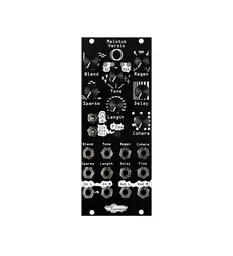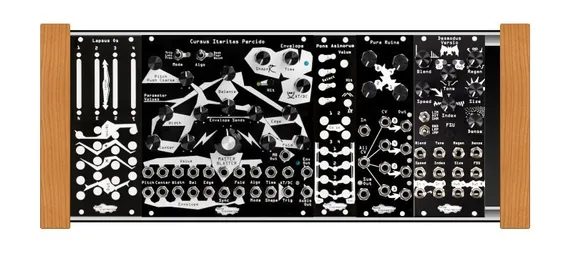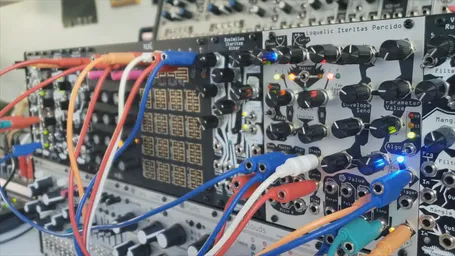This is part of a series of guest-post tutorials from Noise Engineering users showing off various tips for NE modules, modular use in general, or how they integrate modular into their workflow.
This week, Kris chats with someone that most of our Instagram followers have probably seen: musicalfungus. We noticed him posting a while ago and his prolific patches have gained him honorable mention in our Stay Inside and Patch contest a few months ago. We’ve just generally been excited about what he’s been doing. In particular, we spotted him coaxing some really melodic and pretty tones out of the Loquelic Iteritas Percido, which is known for being pretty great for lasers and space farts. It can be a beast, but as musicalfungus demonstrates here, it can be tamed.
Kris: Tell us about yourself.
musicalfungus: My name is Christopher. For the last 10 years, I have created my music under the alias musicalfungus. I am not a professional musician, but I spend most of my time daydreaming of synthesizers during my 9-5 job. While I am constantly recording music, I rarely release outside of Instagram and Youtube. I do have a Soundcloud that archives several years of musical explorations.
Kris: When did you get into modular?
musicalfungus: My free time is spent exploring new ways to express myself through sound as music has always been the driving force in my life, and I have been obsessed with synthesizers for as long as I can remember. Somewhere around 2014 I began my journey down the Eurorack rabbit hole and since that time, I have collected modules and curated a system that allows me to explore sound in ways that I have never imagined. I am very interested in Buchla systems and compose a lot on a Buchla Music Easel. However, most of my music is composed on Eurorack modules. I have just recently begun working with Noise Engineering modules which have added a new and unique timbre to my sound.
Learn more:
Kris: What brought you to this patch?
musicalfungus: Anyone who has had a chance to play with the Loquelic Iteritas Percido knows that it is a very powerful oscillator, capable of creating some of the most harsh and aggressive tones available in the world of modular synthesis. I find that for most situations it offers the perfect sonic palette that can go from simple sines to chaotic complex waveforms at the flip of a switch or turn of a dial. It may be an intimidating module to some and is often revered for its brutal digital timbre. The LIP is a powerful beast. And smashing it with CV can produce powerful sounds. But I wanted to explore the softer side of the Loquelic Iteritas Percido.
Kris: I’m excited about this because I often hear people complain about how aggressive LIP is. And it can be! But like all our oscillators, it can also be quite pretty – it just requires a bit of finessing. Do you have general tips for getting some of these tones out of LIP?
musicalfungus: [U]sing heavily attenuated CV will help tame the beast and allow you to produce less chaotic sounds.
Keeping the Shape and Fold parameters at their minimum and using small amounts of voltage to periodically raise the levels of each parameter will allow bursts of harmonically rich sound to become prominent and then fade away. When combined with delay and reverb those bursts of harmonics echo along with the melody adding depth and complexity with each pass of the sequence. The same technique can be applied to the Mod and Damp parameters as well with the result dependent on the algorithm.
Kris: Nice. We have quite the patch breakdown here, so let’s split this into sections.
Basic overview
The patch in the example video is 100% Loquelic Iteritas Percido audio with a little delay and reverb from the Make Noise Mimeophon. The CV and gate sources were kept as simple as possible with the intention of creating a complex soundscape with just 1 sound source. There are five gates, two stepped CV sources, and one envelope. The gates come from the Noise Engineering Horologic Solum with HU expansion, utilizing the /1, /24, and /128 outputs. The Make Noise Rene provides two further gates with its X and Y gate outputs. The two stepped CV sources come from the Make Noise Rene’s QCV and CV outputs and the single envelope comes from the LIP’s own internal envelope.
Tremolo
Some of the most interesting sounds that I create with the LIP are using the Master switch in the center position. This [is how I get those] tremolo- and vibrato-like effects. The effect is dependent upon the frequencies of the oscillators and the state of the Master sync switch and is not as prominent when either oscillator is synced. [Here] when the Master sync switch is in the center position, we hear the strongest intermodulation which produces the tremolo effect. When the switch is flipped to either A or B position, one oscillator syncs to the other, and the tremolo effect is gone. In this patch, the CV is a gate signal from the Horologic Solum master clock at a division of 128. Every 128 beats the gate goes high and flips the master switch. The tremolo effect happens until the gate goes low and switches back to position A.
Algorithmic shifting
One of my favorite ways to get the most from [the LIP] is to send varying CV sources to any of the LIP’s parameter inputs to create a consistently updated waveform. Next I send CV to the Algo input to scan through each of the three algorithms. [In the video, I] use the LIP’s own envelope for rhythmic modulation. The position of the Algo switch acts as a baseline for the modulation, so depending on the CV source, you can play with switch positions to have one algorithm be more prominent than others.
Envelope modulation
I’m also modulating the LIP’s envelope, which is one of my absolute favorite ways to animate a sequence. Here I use the 16-step sequence from the Rene to vary each repetition: each step can have a different length, and I can add short percussive clicks and pops with no attack and exponential decay side-by-side notes that have longer logarithmic attack and decay stages. I have the LIP’s envelope on Loop, and modulating Shape with a 16-step CV sequence while the envelope’s curve is modulated by a rhythmic gate source, both from the Rene.
Kris: Cool. It sounds beautiful and almost otherworldly! I wouldn’t guess that this is the LIP if I just heard it.
This is a pretty simple patch: HS, Rene, LIP, and Mimeophon, but if someone doesn’t have these in their system, what might you suggest?
musicalfungus: This patch can be easily recreated with any clock and CV source. One suggestion that comes to mind is Mutable Instruments Marbles with its 7 interconnected gate and CV sources. Another fun experiment is using only gates to sequence everything. Rhythm generators such as the Numeric Repetitor and the Zularic Repetitor are great options to explore that technique. Experiment using different CV sources to modulate the envelope’s shape, curve, and time. Gates are a great way to sync the envelope modulation to a clock source or rhythm generator, but random voltage produces great results as well.
If you’ve never explored the softer side of the Loquelic Iteritas Percido I hope this has provided some inspiration. There is a whole universe of beautiful sounds within these circuits.






